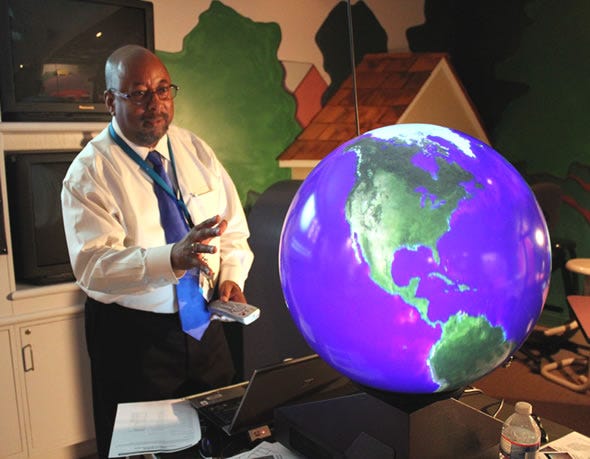Digital Globes: New Spin On Classroom StapleDigital Globes: New Spin On Classroom Staple
Right now digital globes are too expensive for most classrooms, but promise an exciting new way to teach geography and more.


8 MOOCs Transforming Education
8 MOOCs Transforming Education(click image for larger view and for slideshow)
The classic image of education features a chalkboard, books on desks and a classroom globe. All are still in use, but smart boards and digital textbooks are spreading rapidly. The newest player? The digital globe. But it's not as widespread, at least not yet.
That's because digital globes cost tens of thousands of dollars, versus an array of smart boards available for under $2,000, or digital textbooks, which can be free.
Digital globes, as the name suggests, are spherical but capable of displaying different global images, controlled by a PC or other video source. Operators -- museum personnel, corporate speakers, teachers -- can toggle between familiar static images such as terrain and newer views such as real-time weather patterns or animal habitats.
[ Want more on online courses? See our slideshow, 12 Open Educational Resources: From Khan to MIT. ]
The MathScience Innovation Center spent $39,500 for an 18-inch digital globe, called a Magic Planet, a carrying case and related software from Global Imagination. The MSIC serves 170,000 students in the Richmond, Va., area. "Funding was an issue," said Carroll Ellis, Earth and environmental science educator at the MSIC. "We had to look at grant funding."
Ellis felt the money was worth it to use an actual sphere for teaching astronomy, and for the Center's innovation mission. "When you go into a classroom you want something different and here at the Center that's what people expect from us," he said.
Ellis developed a curriculum built around an alien named Bob, who can change into any planet in the solar system, as well as other objects in outer space. Ellis goes out into the schools four days a week to teach the 90-minute lesson on the planets, primarily to area sixth graders. He says the globe, in its case, weighs about 50 pounds. He's now developing climate-related curriculum. The MSIC has anecdotal evidence that the digital globe improves learning, and is developing some ways to measure its impact.
There are no hard numbers available to measure the impact at the Rochester, Minn., public schools, either. There's been a 36-inch Magic Planet in the school district's planetarium since 2007, said Larry Mascotti, planetarium director for the Rochester Public Schools. The district spent nearly $50,000 to acquire its Magic Planet. He, too, cites anecdotal evidence based on observation of how students engage with the globe.

Carroll Ellis
"One reason why we purchased it is it's a dynamic virtual teaching tool," Mascotti said. "It evolves with time. When new datasets are available we can use them. It's a very democratic teaching tool."
In Rochester, students come to the facility. Mascotti has a 90-minute session with third graders, teaching them how to tell the difference between stars and planets in the night sky, among other things. He also has developed lessons for eighth graders on plate tectonics on Mars and on Earth. He's working with teachers in the district to develop materials on geography, and is also exploring using the Magic Planet to teach math. One place that has looked at the impact of digital globes on education is China. A study by the Chinese Ministry of Education's Educational Equipment Research Institute looked at 700 students who spent a year with the Magic Planet in class, using it with 15 different topics, and a control group of 700 that did not. It found that students in the Magic Planet classrooms averaged comprehension levels 16.5% higher than the students in the control groups. It also found that 100% of students in classes with the Magic Planet participated, while just 80% of the control group participated.
China has recommended the Magic Planet as a piece of standard classroom equipment, which has swamped Global Imagination's production in Campbell, Calif. "We can't keep up with demand," said Mike Foody, CEO of Global Imagination. China was already by far the company's largest market, with more than 1,500 globes installed in 800 schools. In contrast, there are six school districts in the U.S. using its globes. (Others might use digital globes from rivals such as iGlobe or ARC Science.)
Foody said his company has about 1,200 globes on order, 1,000 of those bound for China. But he can envision hundreds of thousands of orders. He says if he can get prices down to about $2,500, every one of China's 440,000 schools will buy one.
To meet that $2,500 price, he's hoping to convince a Chinese manufacturer to produce globes. China is the main source for the specialized projector components that power the digital globe's display.
Schools are a breakout market for the Magic Planet, first sold to NASA and to museums. Foody said they work well for teaching, because they offer 3-D visualization for objects that are indeed three-dimensional. He says the brain has to do a lot of work to convert a flat map into a 3-D image.
However, he said that entrepreneurs often underestimate how much time it takes adopters of new education technology to do new things. "You hear a lot about revolutionizing education and completely revamping the way it's done," Foody said. "One of the biggest challenges is teachers don't have a lot of time."
Ellis, for instance, spent nearly three months developing his Magic Planet curriculum in Richmond. But as the globes spread in education, resources should increase, which might help teachers round out their lesson plans.
About the Author
You May Also Like






